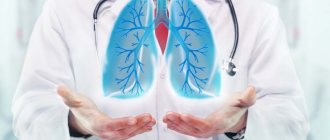Interstitial lung diseases (ILD) are various lesions of the pulmonary system, the pathomorphological basis of which is chronic inflammation of the alveoli, small bronchi, and capillaries of the lungs, leading to fibrosis. ILD includes more than a hundred diseases with clear and unclear etiology.
In patients who are hospitalized in the pulmonology department of the Yusupov Hospital, certain interstitial lung diseases are diagnosed in 20% of cases. The disease is more common in men under the age of 70 who have been smoking cigarettes for many years. Some diseases in this group have a reversible course and a relatively favorable prognosis, while others lead to early disability and even death.
Pulmonologists at the Yusupov Hospital have extensive experience in diagnosing and treating interstitial lung diseases. Patients are examined using modern devices from leading global manufacturers. The hospital cooperates with leading medical universities in Moscow and specialized pulmonology centers. For this reason, patients have the opportunity to undergo complex examination and treatment. The Yusupov Hospital has all the conditions for a comfortable stay for patients: cozy rooms, polite medical staff, competent doctors.
Classification of IBL
Currently, the classification developed in 2002 by the American Thoracic Society (ATS) and the European Respiratory Society (ERS) is adopted as the basis. According to this classification, there are interstitial lung diseases. With established etiology:
- Radiation, medicinal, toxic;
- Pneumomycoses associated with HIV infections
- Interstitial lung diseases against the background of collagenosis and pneumoconiosis;
- Interstitial lung diseases due to infections;
- Interstitial lung diseases against the background of allergic alveolitis.
Idiopathic interstitial pneumonia:
- Nonspecific, lymphoid, acute, desquamative, cryptogenic organizing;
- Idiopathic pulmonary fibrosis.
- Granulomatous: interstitial diseases against the background of sarcoidosis, exogenous allergic alveolitis, hemosiderosis.
Associated with other diseases:
- Pathology of the liver, intestines, kidneys;
- Hereditary diseases;
- Malignant neoplasms.
Other: associated with primary pulmonary amyloidosis, pulmonary proteinosis.
Pathologists distinguish the following types of fibrosis in interstitial lung diseases:
- Simple;
- Desquamative;
- Lymphocytic;
- Bronchiolitis obliterans with pneumonia;
- Giant cell.
Make an appointment
Causes
To date, the etiological mechanisms are not fully understood. We can only speak reliably about causes with a known etiology:
- Inhalation of inorganic substances;
- Organic dust;
- Mercury vapor;
- Taking toxic medications;
- Radiation therapy.
The development of such diseases may be based on recurrent bacterial, fungal and viral pneumonia, tuberculosis, respiratory distress syndrome, and cancer.
In addition, interstitial lung diseases can be accompanied by blood diseases, hereditary diseases, and others. The most important risk factor is smoking. The pathogenesis of interstitial lung diseases is divided into acute, chronic and terminal stages. In the acute stage, the pulmonary capillaries and epithelium are affected, and edema develops. During this period, reversibility of changes or their progression is possible. In the chronic course, there is extensive damage to the lungs. In the terminal stage, the alveoli and capillary network are replaced by fibrous tissue with the formation of dilated cavities.
general information
What is interstitial lung disease (ILD)? This is a lesion of the pulmonary system, characterized by diffuse inflammation of the lung stroma, as well as the alveoli and bronchi.
The interstitium is the tissue that surrounds and separates the alveoli in the lungs. Inflammation of this particular tissue is ILD. And since this process is diffuse in nature, it spreads throughout the entire organ and is not localized in one area.
The outcome of this pathological process is fibrosis - the proliferation of connective tissue with the appearance of scar changes, resulting in impaired respiratory function. The group of interstitial lung diseases includes many pathologies. One of these diseases is diagnosed in every tenth patient of the pulmonology department. Most often, IPD is found in actively smoking men over 40 years of age.
Symptoms
Despite the diversity of etiological forms of interstitial lung diseases, their symptoms are largely similar and are characterized by general and respiratory symptoms. Often the disease begins gradually, the manifestations are not typical. General symptoms:
- Fever;
- Malaise;
- Fast fatiguability;
- Loss of body weight;
- Shortness of breath, which is accompanied by wheezing, which is why it is often mistaken for bronchial asthma;
- Unproductive cough - dry or with scanty mucous sputum;
- Cyanosis;
- Changing fingers to the “drumstick” type and nails to the “watch glass” type;
- Chest deformity;
- Pulmonary heart failure (in severe forms).
Possible complications
Delayed diagnosis and incorrect treatment tactics can lead to severe complications:
- Pleurisy.
- Destruction of lung tissue.
- Purulent lesion of the lungs.
- Pneumothorax.
- Cardiovascular failure.
- Pneumosclerosis.
Diagnostics
When examining a patient, the pulmonologist pays attention to tachypnea (rapid breathing), a discrepancy between the severity of shortness of breath and physical changes in the lungs.
During auscultation, crepitating rales are heard during inspiration. A general blood test revealed moderate leukocytosis and increased ESR. The gas composition of the blood changes. Arterial hypoxemia (lack of oxygen) is determined, which can be replaced by hypercapnia (excessive carbon dioxide in the blood) in the terminal phase. CT diagnostics, as well as lung radiography, are of great information value for interstitial lung diseases. The Yusupov Hospital has the most modern equipment - a multislice computed tomograph, thanks to which the research is safe, fast and of high quality. In the early stages of the disease, images can show deformation and intensification of the pulmonary pattern, decreased transparency of the lung fields, and finely focal shadows. Next, a picture of interstitial fibrosis and “honeycomb lung” develops.
According to spirometry, disturbances in pulmonary ventilation and a decrease in volumes are detected. The ECG shows myocardial hypertrophy in the right heart. The most important diagnostic method is histological confirmation of the diagnosis. To obtain material at the Yusupov Hospital, the following methods are used:
- Cytological examination of pleural fluid;
- Percutaneous fine needle biopsy of the lung;
- Study of bronchial and bronchoalveolar lavages;
- Brush biopsy and pinch biopsy of the bronchi;
- Biopsy of lung tissue, pleura and mediastinal lymph nodes during videothoracoscopy, thoracoscopy or mediastinoscopy.
The collection of material for research is carried out by highly qualified specialists who are fluent in the methodology of performing the procedure. To examine patients, they use modern equipment from leading companies in the world.
The role of the interstitium in kidney function
The interstitium has a second name - interstitial tissue, or stroma. As you know, any parenchymal organ, such as the liver, kidney or spleen, consists of functional tissue and support, including mechanical support. The supporting tissue, which provides the architecture of the entire organ, arranges rows of functional tissue in the form of lobules, provides the supply of blood vessels and lymphatic capillaries to them - called stroma, or interstitium. In addition to mechanical support, the interstitium performs certain functions in each parenchymal organ. Thus, almost everywhere this tissue participates in various reactions of cellular immunity.
As for the kidneys, the role of interstitial tissue in this organ is special. It is worth recalling that the structural and functional unit of the kidney, responsible for purifying the blood of various “toxins”, is the nephron. This is a complex structure that includes the choroid glomerulus, Bowman-Shumlyansky capsule and special renal tubules. Various processes of secretion and reverse reabsorption take place in them, that is, not only the penetration of excess substances into the urine, but also the absorption back into the blood of those that are still needed by the body.
In the structure of the kidney as an organ, nephrons are located in a strictly defined position. Thus, in the renal cortex there are capsules, in the outer medulla there are proximal and distal tubules, in the inner medulla, in the deepest structures of the kidneys, there are thin sections of tubules. Then the nephrons turn, and the initial parts of the collecting ducts are located in the outer parts of the cortex, and then the collecting ducts go vertically down. Penetrating the entire thickness of the cortex and medulla, they open into the pyelocaliceal system of the kidneys (
).
But all sections of the nephrons cannot hang in the void; they are located in the middle of the interstitial tissue. In addition to mechanical support and blood supply to nephron areas, the renal interstitium plays a very important role in maintaining water-electrolyte balance, as well as acid-base balance. Only in renal tissue does interstitial tissue, or interstitial tissue, play an important role in the regulation of blood pressure. Mechanically, the renal interstitium consists of loose connective tissue as well as stellate fibroblasts. The interstitium is most pronounced in the medulla, and in the cortical layer its structure is rather weak, since the tubules there are close to each other.
In various chronic and acute inflammatory diseases of the kidneys, the interstitium often changes. Under hypoxic conditions, fibroblasts begin to excessively produce loose fibrous connective tissue, which negatively affects the functioning of the tubules and leads to their atrophy. Stimulation of fibroblasts can occur under the influence of various cellular signals, such as cytokines and growth factors in immunopathological processes. The damaging factor that triggers the interstitial response to inflammation may also be massive proteinuria.
Treatment and prognosis
The first step in the treatment of interstitial lung diseases should be giving up bad habits - smoking, interaction with toxic production factors, dangerous drugs.
All subsequent treatment is carried out in parallel with the treatment of the underlying disease. The first-line drugs for the treatment of IBL are corticosteroids (prednisolone), which are prescribed in large dosages for three months with a gradual transition to a maintenance dose. If positive dynamics are not observed throughout the year, cytostatics (cyclophosphamide, azathioprine, chlorambucil) are prescribed. Other pharmacological drugs include bronchodilators (orally and inhaled). They are effective only at the stage of reversible bronchial obstruction. For arterial hypoxemia, oxygen therapy is used. In severe cases of interstitial lung disease, the only effective treatment may be a lung transplant.
The outcomes of interstitial lung disease can be positive dynamics, stabilization of the condition, progression in the form of complications, death, and less often - spontaneous regression of changes. The average life expectancy of patients ranges from 1 year with Hamman-Rich disease to 10 years or more with respiratory bronchiolitis. Prevention of interstitial lung diseases is possible only if the cause of their occurrence is established.
The best specialists in the country work at the Yusupov Hospital. Doctors select therapy and monitor patients’ condition in accordance with international and Russian standards. The Yusupov Hospital uses innovative diagnostic equipment that detects changes in lung tissue at the earliest stages. You can make an appointment and consultation with a specialist at the Yusupov Hospital online on the website or by calling.
Make an appointment
Who is the pathogen?
The infectious factor can be viruses, bacteria, fungi. Regardless of the type, the pathogen is not the root cause of the disease. The inflammatory reaction develops according to a typical scenario. If at the end of the classical inflammatory process the stage of tissue regeneration begins, then in the case of interstitial pneumonia the formation of connective tissue is observed. Why does it happen this way? The question is still open to this day.
There is an opinion that the patient’s body undergoes certain changes, as a result of which it regards its own cells as foreign.






